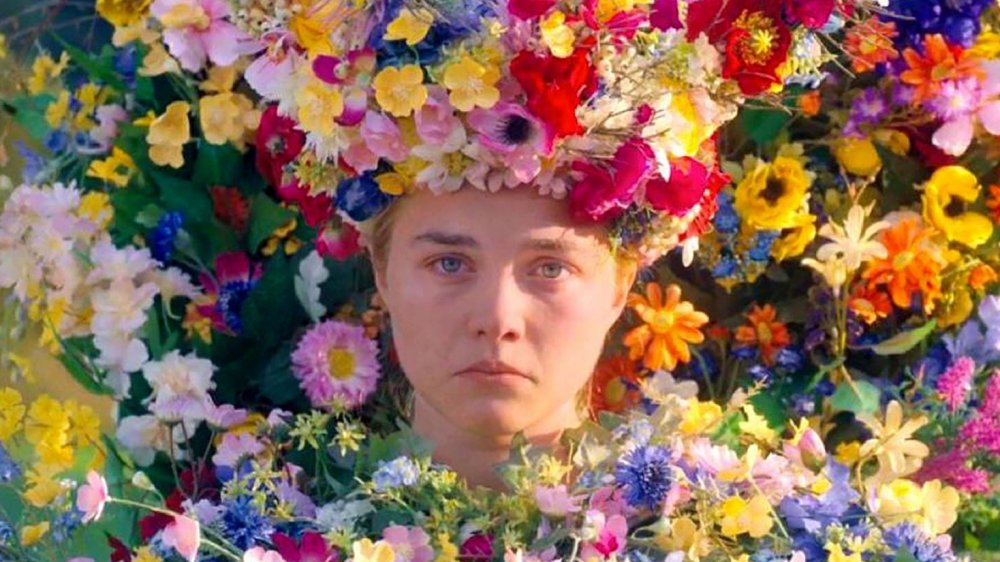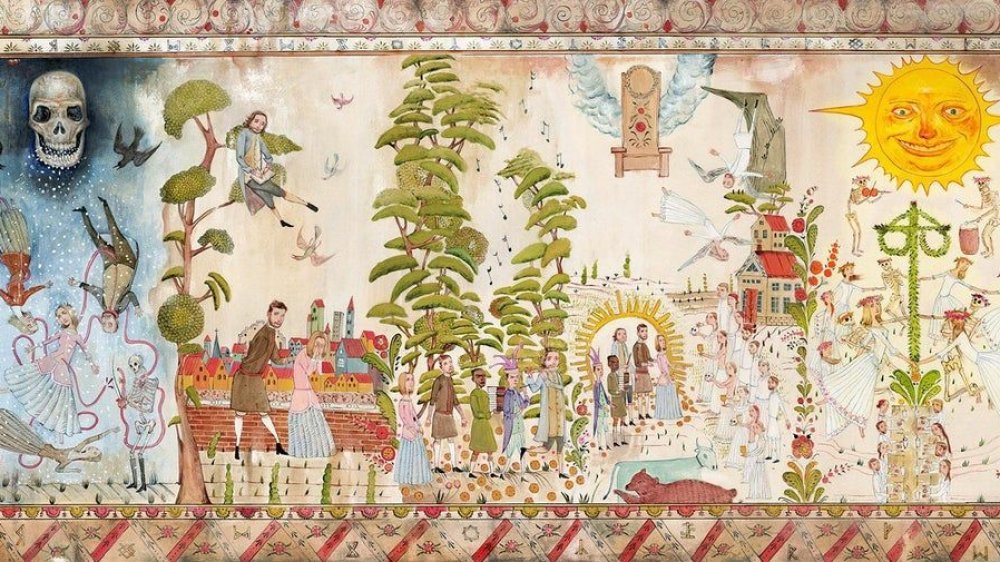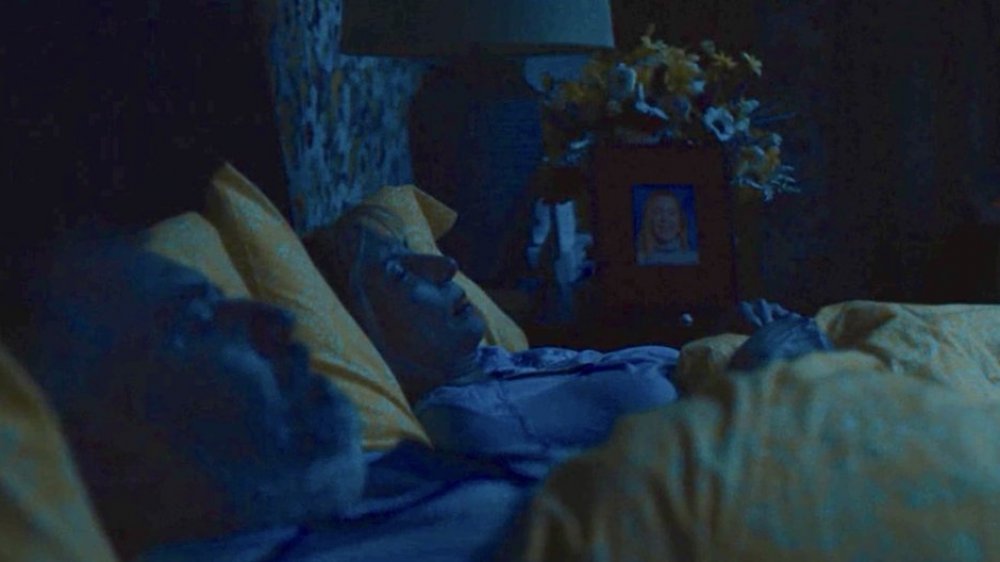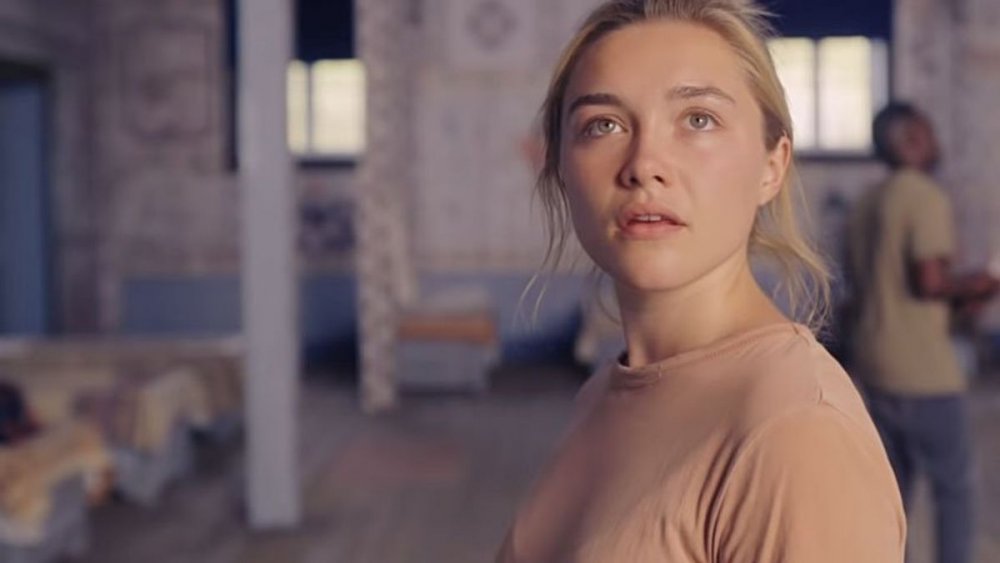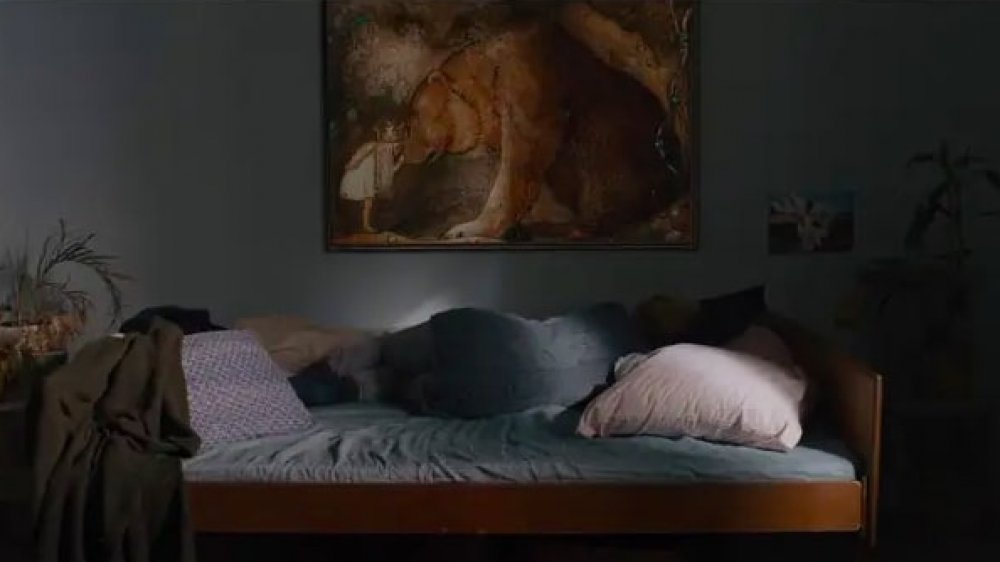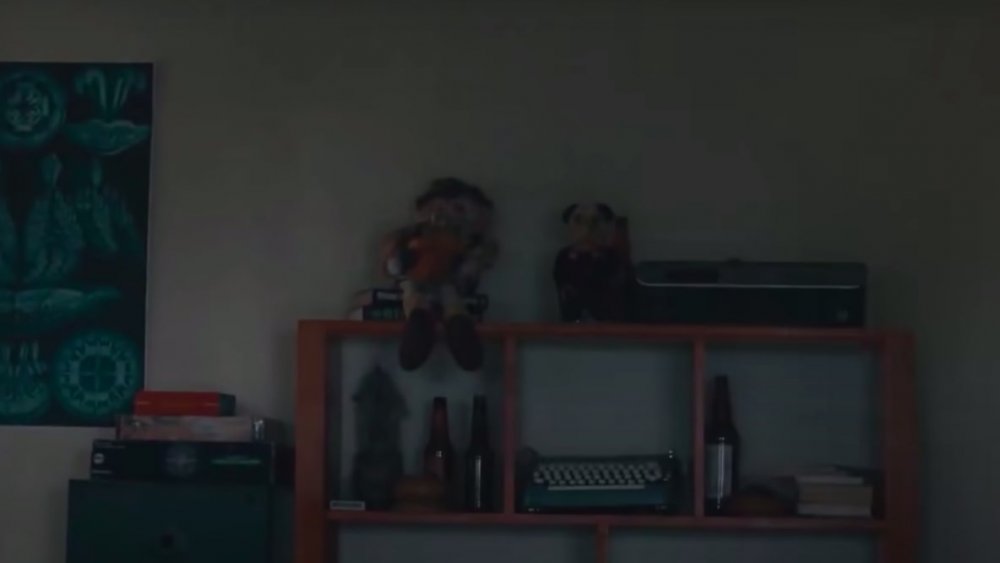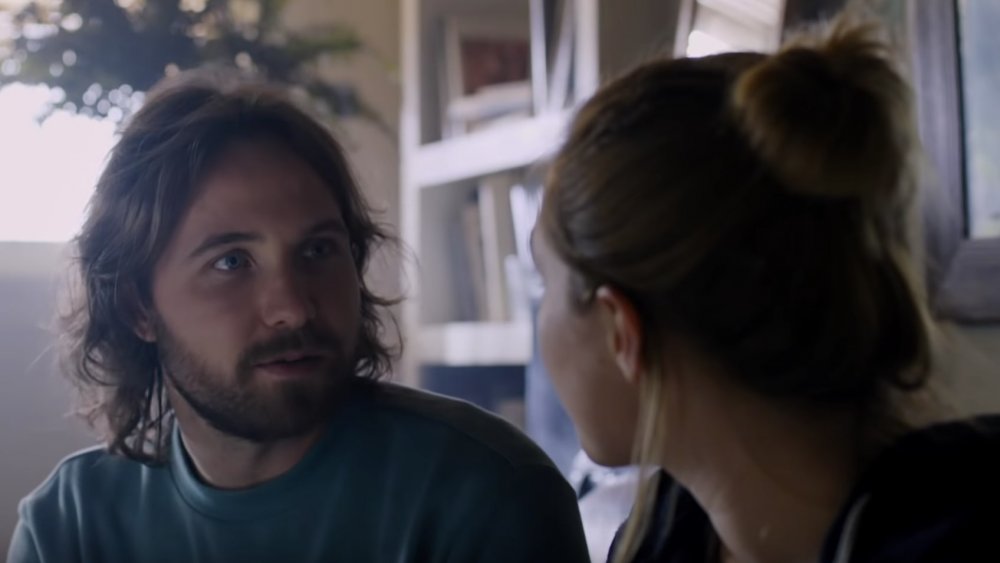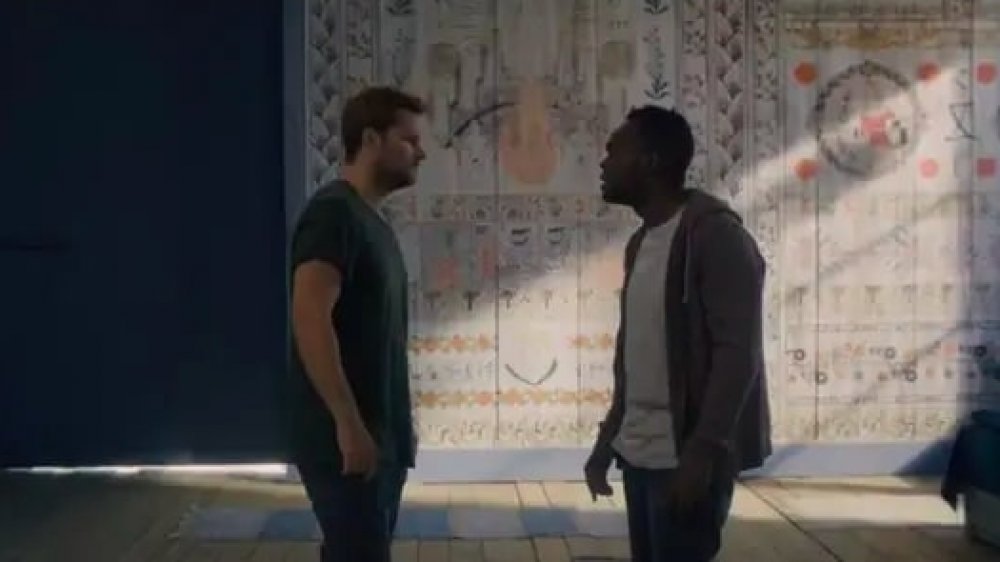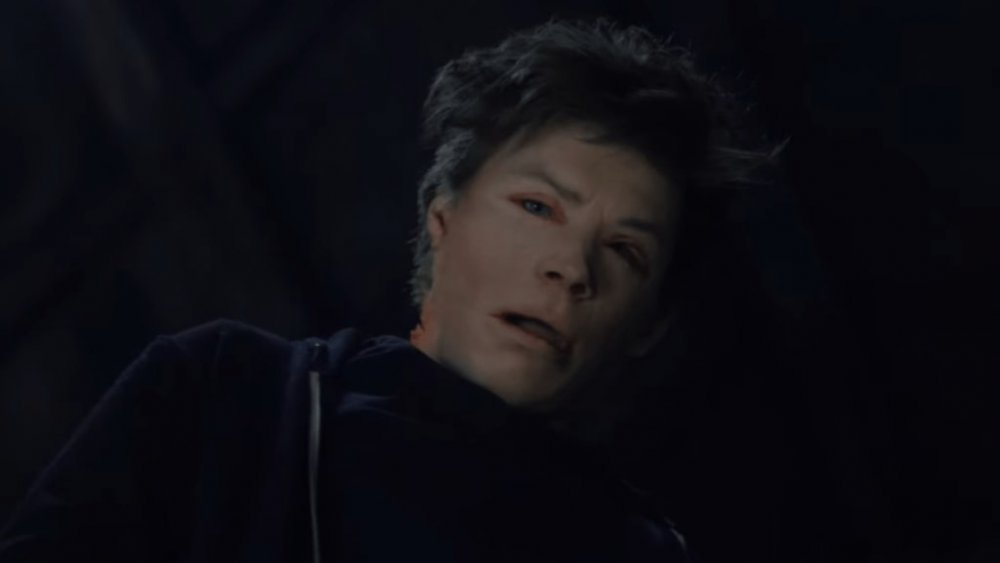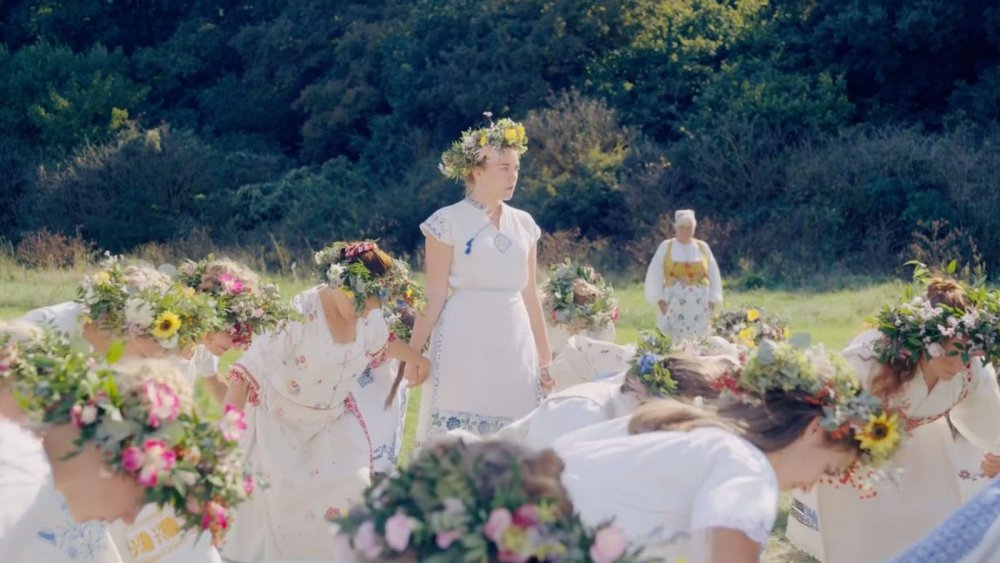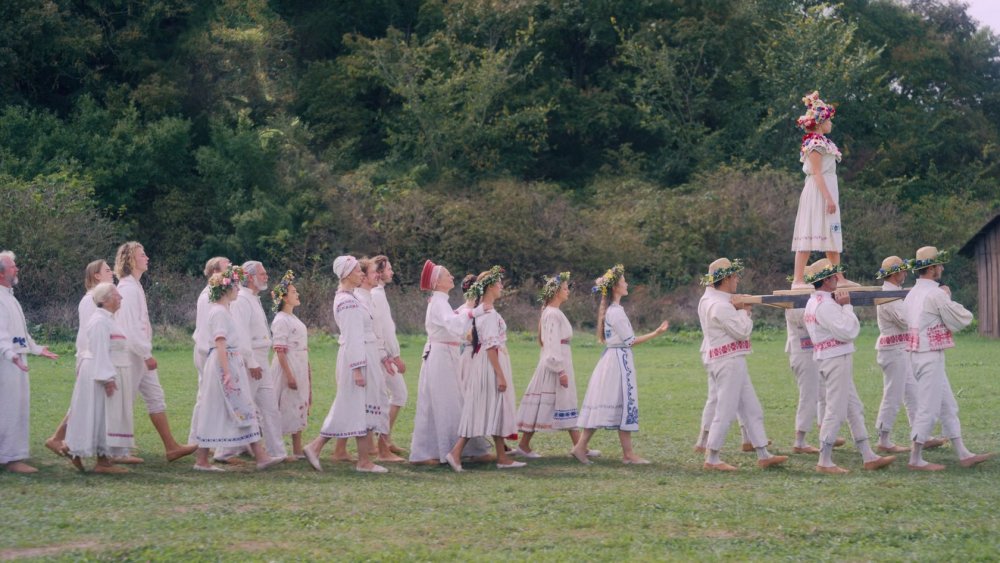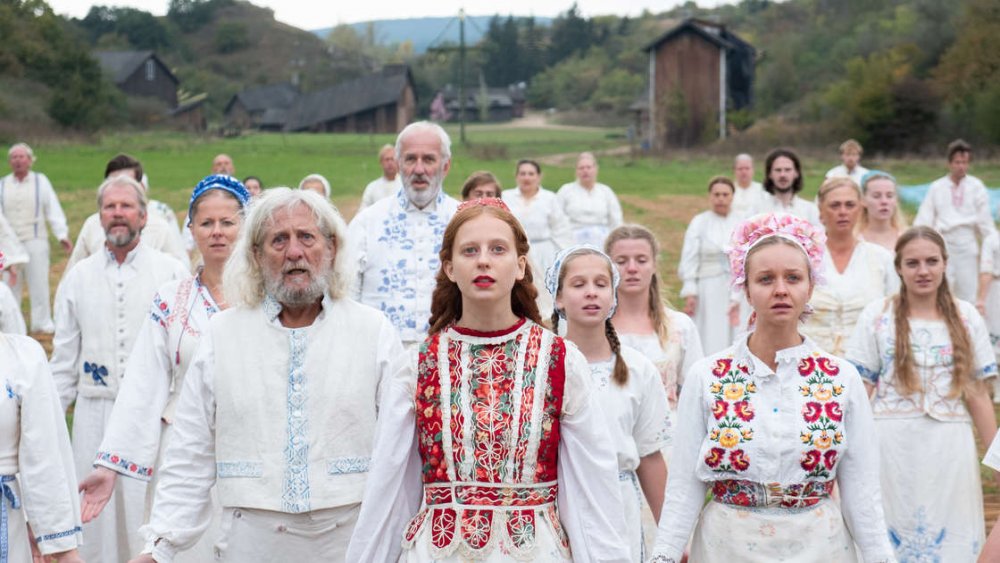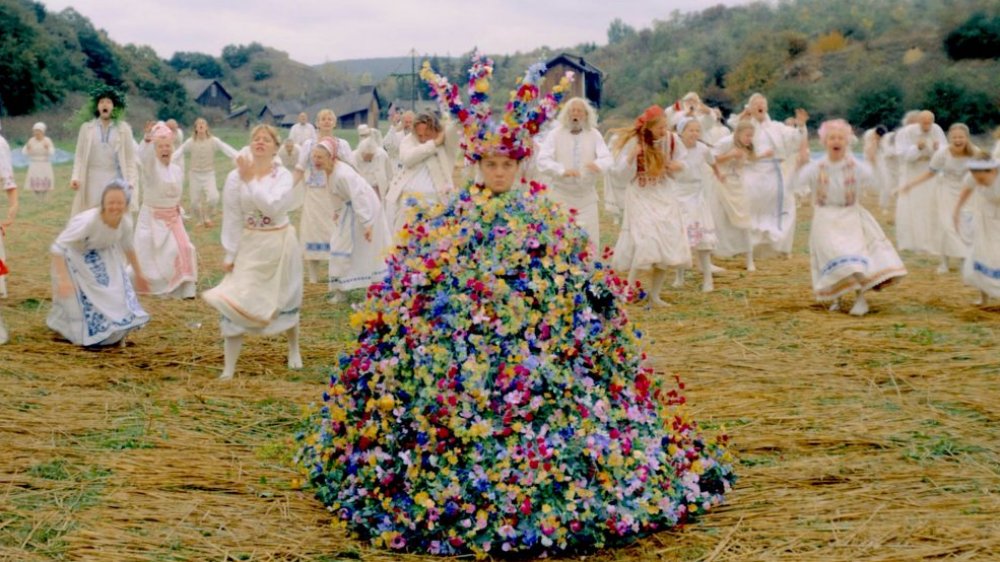Things You Only Notice The Second Time You Watch Midsommar
In Ari Aster's folk horror film, Midsommar, a couple on the verge of breaking up finds themselves entangled in the strange rituals of a pagan cult. It all starts after Dani (Florence Pugh) loses her entire family in a tragic murder-suicide, and she ends up tagging along on a trip to Sweden with her inattentive boyfriend, Christian (Jack Reynor), and his friends, Mark (Will Poulter) and Josh (William Jackson Harper). They were invited by their classmate, Pelle (Vilhelm Blomgren), who comes from a small Swedish community known as the Hårga. He wants the group to join them for the community's sacred Midsommar festival ... but Dani slowly come to find that this is no friendly gathering.
Unlike Aster's previous film — the incredibly disturbing Hereditary — Midsommar is the rare horror movie in which the terror plays out under broad daylight. On top of that rare distinction, the film is packed with symbolism and Easter eggs that might not be obvious, even to eagle-eyed viewers, upon their first watch. But if you return to the film and pay close attention, you're bound to notice the many hidden clues that Aster cleverly concealed in background imagery. Plus, you might pick up on a few throwaway lines that hinted at deeper, darker meanings. If you're brave enough to watch Midsommar a second time, you should definitely keep an eye out for these details.
(Be warned — we're spoiling the entire movie.)
The opening tapestry in Midsommar is full of foreshadowing
Before the film begins, we see a colorful, folksy tapestry covered with intricate designs. Sure, it looks creepy at first glance, but it's easy to assume that this was simply included to set the mood for the movie. However, if you happen to pause the film and closely examine the tapestry, you'd find that it reveals many important events to come. In fact, much of Midsommar's narrative is illustrated on this incredibly eerie tapestry.
On the left, you can see the bodies of Dani's parents and sister connected by a tube, with a skull looming above them, representing their deaths. Next up, a grieving woman and her partner walk with a group of friends to an idyllic community, where they're greeted by a crowd of villagers all dressed in white. Finally, there's the dance around the maypole — complete with a few skeletons among the dancers — and the subsequent banquet. You can even spot Pelle spying on Dani and Christian from his vantage point, two people dressed in white diving off a cliff, and a bear near the entrance to the village. In other words, Midsommar basically spoiled its own plot twists, but you wouldn't know it unless you watched the film twice.
On your second viewing, notice the flower crown around Dani's photo
Even though their deaths are integral to the plot, we only see Dani's parents for a brief moment in the film. When Dani calls them, worried about her sister, they're shown sleeping in their bed. On their dresser, you can see a photo of Dani, which just happens to be surrounded by flowers. Upon a second viewing, this instantly calls to mind the later scenes of Dani wearing a flower crown after becoming the May Queen.
Some fans have theorized that the flowers actually indicate that Pelle is responsible for the death of Dani's family, and he orchestrated the entire tragedy just to lure Dani into the cult. But writer/director Ari Aster says that this explanation doesn't hold up. "I can go as far as to say that it's totally incorrect. He is not [responsible]," Aster explained to The Huffington Post. However, he did state that the flowers were an important symbol, explaining, "It was our way of weaving in the idea that whatever is inevitable is bound to happen."
Pay attention to Dani's last name
Although Dani's parents are barely in Midsommar, there's a brilliant little detail included in the moment where we see the doomed couple in bed. When their answering machine picks up Dani's call, you can hear their recorded message state that their last name is "Ardor." Why is this significant? As it turns out, the Latin word "ardor" loosely translates to "heat" or "to burn." Not only are Dani's travel companions burned in the sacrificial fire in the final scenes of the film, this fire also represents a sort of spiritual rebirth for Dani. Whether she descends into madness or finally experiences true catharsis after grieving, there's no denying that by the end, she has gone through a dramatic change.
It seems like Aster chose this particular name to emphasize that Dani's path has been set from the start. In some sense, even before she met Pelle and went to Sweden, it seems that Dani was always destined to be the May Queen and join the Hårga. Despite the flames, it's chilling to think about.
There's a painting hinting at Dani and Christian's fate
While watching Midsommar for the first time, it's easy to blink and miss all of the clues and symbols hidden within the background artwork. But upon your second watch, look closely. When it comes to Ari Aster's sets, there are no accidents, and all of the artwork reveals hidden details about the horror that's going to unfold.
After witnessing what happened to Dani's family, we see how her life plays out in the aftermath — she spends much of her time isolated and sleeping in her apartment. In one scene, she's shown napping on her couch, right underneath a painting that actually gives us a peek at what's coming later. In the painting, a girl wearing a crown is kissing a brown bear on the nose. This symbolizes Dani and Christian's relationship, and if you've already seen Christian meet his end in the bear suit, there's no question as to why this painting was chosen. And similar imagery warns Christian of what's ahead for him shortly before he is sacrificed. While he's sitting in Siv's (Gunnel Fred) house, he's staring directly at an image of a bear on fire.
Midsommar's sneaky scarecrows
When Dani's friends are killed by the Hårga, their bodies are stuffed and dressed like scarecrows before they're burned. It's an unsettling sight, but even in the early scenes of the film, there are a few very subtle hints that point towards these events. For example, when Dani and Christian are hanging out with Christian's friends before their trip to Sweden, a framed photo of the Scarecrow from The Wizard of Oz is visible on top of a refrigerator in the apartment. Furthermore, there's a stuffed scarecrow doll sitting on top of a shelf.
These scarecrows probably wouldn't grab anyone's attention on the first viewing of the film. After all, the first time around, there's no way of knowing their relevance to the plot. But Aster definitely included them on purpose, and there's another layer of meaning to these details. Speaking with Vulture, Aster called the film "Wizard of Oz for perverts," and during a conversation with The Nerdist, the director said that he noticed ("mostly in retrospect") quite a few parallels between his movie and the Judy Garland classic, as they're both stories of young women who travel to a strange new world, along with several bumbling sidekicks, and truly find themselves. Plus, the color scheme even changes when Dani shows up in Sweden, switching from a darker tone to a much brighter hue.
What really happened to Pelle's parents?
When Dani expresses her distress over watching the gruesome ättestupa ceremony (where those elderly people jump off a cliff) and begins packing up to leave, Pelle steps in and tells her that he understands why it was so upsetting for her. He reveals that he also struggled with grief after his parents died in a fire.
The first time you see Midsommar, it's easy to assume that Pelle does genuinely relate to what Dani's going through. Clearly, he lost his parents in a tragic accident, too, and he's just trying to empathize with her, right? But when you watch this particular conversation with the knowledge of the Hårga's traditions of fiery human sacrifices, it opens up new possibilities.
Was Pelle telling a half-truth when he talked to Dani about his past? Perhaps his parents really did die in a fire ... but what if their death was part of a sacrificial ceremony, like the one we saw in the film? Alternatively, Pelle could have been bluffing about his family history entirely. After all, he clearly knew what the rest of his community had in store for his friends, and he was obviously attracted to Dani. Maybe he was trying to exploit her vulnerabilities and convince her that she could trust him. Either way, the conversation takes on a whole new tone.
Notice the eerie artwork in the bunkhouse
The artwork is Midsommar might be done in a cute, folksy style, but if you really pay attention to those images, they'll send a shiver up your spine. The images throughout the film are meant to foreshadow all the awful things to come, and that's true of the paintings inside Dani's lodge in Sweden. During their stay with the Hårga, Dani and her friends sleep in a large bunkhouse with the villagers. The walls are covered in paintings, some of which prove to be pretty important.
Josh wanted to travel to Sweden to conduct research for his anthropology thesis. Christian, a fellow anthropology student, eventually decides that he also wants to write his thesis on the Hårga, which angers Josh. As the two argue, you might notice the visuals on the walls of the bunkhouse directly behind them. Between the men, you can clearly see an illustration of a fire. This is just another hint at what's to come for Christian. And in a way, it was Josh's interest in the Hårga's traditions in the first place that lead them to their fate, and now, there is no escape.
'Skin the Fool' takes on a new meaning the second time you watch Midsommar
Not long after arriving at the village, Dani and her friends watch the Hårga children play a game they're unfamiliar with. When they ask Pelle, he tells them that the game is called "Skin the Fool." Their friend, Simon (Archie Madekwe), jokes that it sounds "precious," and the moment is quickly forgotten. It isn't until later that we realize the significance of this line.
Mark, one of Christian's friends, doesn't come across as particularly bright, and he's often the butt of the joke. It's no surprise that he's the first of the group to disappear, and for a while, viewers are left wondering what happened to him. It all makes sense when Josh sneaks out in the middle of the night to secretly read the Rubi Radr, one of the Hårga's sacred texts. He's shocked when Mark shows up, too ... but upon closer inspection, he realizes that it's not Mark at all. It's a villager by the name of Ulf (Henrik Norlen), wearing Mark's face as a mask. As it turns out, "skin the fool" wasn't just a children's game.
There's a callback to the death of Dani's sister
Before committing suicide, Dani's sister sends her a message, saying that everything feels "black." She felt like there was no way out from her suffering, and upon her death, that suffering becomes Dani's burden to carry. And no matter how far she runs, Dani cannot escape the tragedy that befell her family.
But there's an interesting callback to this line just before the May Queen dance kicks off. When Irma (Anki Larsson) announces the beginning of the dance and explains the purpose of the tradition, she states that it's performed in defiance of "the black one," which is likely some sort of evil spirit that the Hårga believe in. Dani appears liberated as she dances, and she's embraced by the Hårga women. Dancing doesn't free her from her grief entirely, but for a while, she's completely absorbed in the competition. Perhaps this is the first time that she's able to forget the darkness that has engulfed her, if only for a little while.
If you or anyone you know is having suicidal thoughts, please call the National Suicide Prevention Lifeline at 1-800-273-TALK (8255).
There are some creepy faces in the background
Throughout much of the film, the characters are under the influence of some serious psychedelics, which makes for some interesting visuals. The walls bend and waver, the ground breathes, and the grass grows through Dani's feet. And sometimes, unwelcome "visitors" show up. After arriving at the festival and taking shrooms, Dani looks into a mirror and sees her sister's face lurking behind her, and it's not the last time that her sister's "ghost" makes an appearance in Sweden when she's hallucinating.
After the May Queen dance, Dani is the last woman standing, and she's welcomed into the fold. However, she's still haunted by the tragedy that happened to her family, and the visuals indicate that her grief lingers on. At this moment, all eyes are on Dani and the procession behind her, so it's all too easy to miss what's going on in the background. But if you look past the procession of the Hårga and into the woods, you'll see the face of Dani's sister clearly visible among the trees.
Midsommar's lack of subtitles
While the American and British characters talk to each other in English, the Hårga mainly speak Swedish throughout the film. After all, among Dani and her friends (except for Pelle), no one knows a word of Swedish, and there are plenty of times when conversations take place that they simply can't understand. While bonding with the Hårga women during the May Queen dance, it seems like Dani is trying to pick up on a few phrases, but she's a long way from fluency.
But the Swedish conversations are rarely subtitled for the benefit of the audience. On your first viewing, you may not have realized just how much Swedish dialogue is never translated, but when you see the film again, it becomes obvious that this was a purposeful choice on behalf of the filmmaker, and it was intended to create a certain isolating effect on the audience. The characters don't know what the Hårga are saying, but as the audience, we're not in on the secret, either. We're just as confused and alone in this strange new community as Dani and her friends.
The passage of time in Midsommar makes more sense with a second viewing
It can be difficult to accurately perceive the passage of time in Midsommar. The fact that nearly the entire film takes place in sunlight makes it hard to keep track of how long the group actually stays with the Hårga. But remember, the festival is supposed to last for nine days. And although the days seem to blend into one another, Aster has confirmed (via Digital Spy) that the human sacrifice doesn't mark the end of the Midsommar festival. In fact, he's stated that there are still several more days of "celebrations" to come.
On your second viewing of the film, you might find it easier to separate when one day ends and the next begins, which opens up new questions about what happens after Midsommar's fiery ending. Who knows what kinds of festivities are in store for Dani? Will she find a home with the Hårga for the rest of her life? Or is she still in danger?
